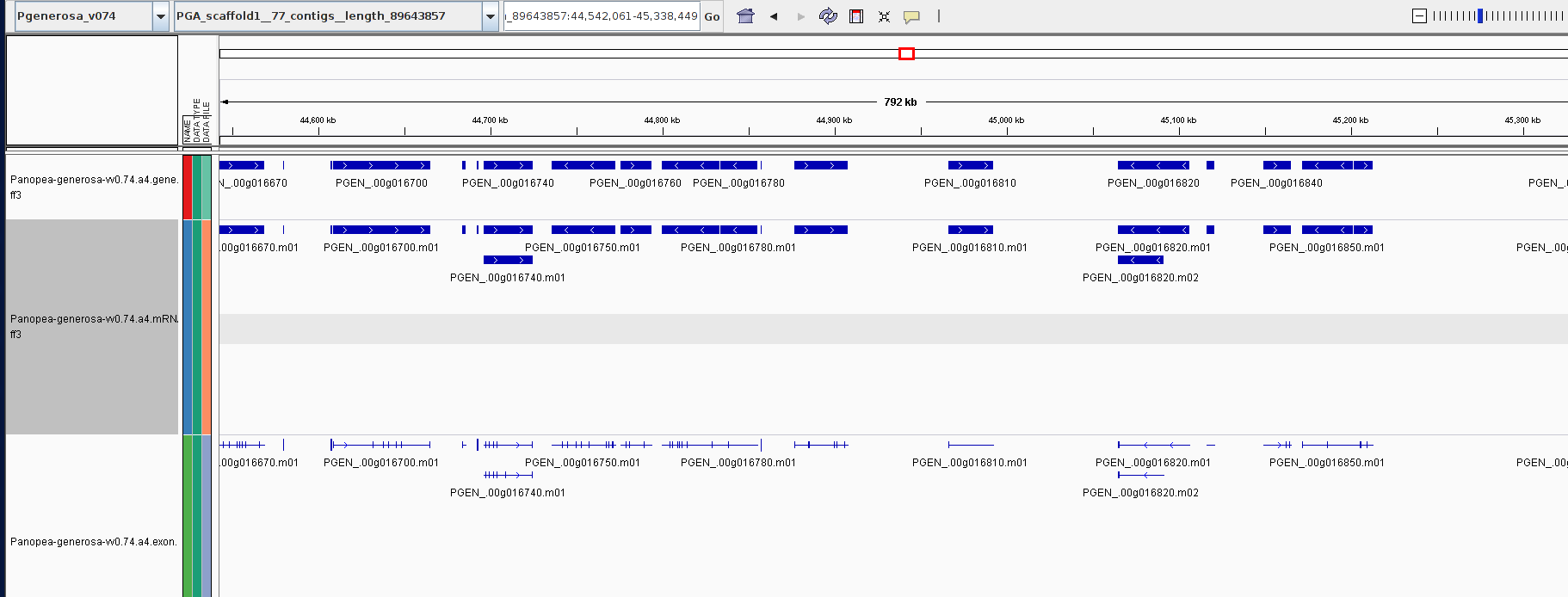I’d previously annotated our Pgenerosa_v074 with GenSAS, but did so using limited options as we were (and still are) in need of an annotated genome to use for methylation data analysis. As such, I opted for speed, but a potentially a less accurate annotation.
Since then, I’ve re-run the annotation, but have, essentially, added all the options. Meaning, I’ve run additional ab initio gene predictors: BRAKER and GeneMarkES (previously, I only ran SNAP and Augustus). I also provided additional data to use as evidence; specifically a singular merged BAM file from the Stringtie Isoform ID I ran on 20190723. I also ran RNAmmer (rRNA identification) and tRNAscan (tRNA identification).
This should amount to a more accurate genome annotation, as the analysis will utilize a plethora of additional data to help predict genes.
This version of the genome annotation will be referred to as:
- Panopea-generosa-vv0.74.a4
RESULTS
Output folder:
Merged GFF (SwissProt IDs in Column 9 - from BLASTp and DIAMOND):
BUSCO assessment (metazoa_odb9):
- 71.5% complete BUSCOs present in predicted genes (Panopea-generosa-vv0.74.a3 had 68.4%)
Feature counts:
awk 'NR>3 {print $3}' Panopea-generosa-vv0.74.a4-merged-2019-10-07-4-46-46.gff3 | sort | uniq -c
236960 CDS
236960 exon
34947 gene
38326 mRNA
1527155 repeat_region
7 rRNA
15514 tRNA
Here’s a feature count comparison between the two different annotations:
| Feature | Panopea-generosa-vv0.74.a3 | Panopea-generosa-vv0.74.a4 |
|---|---|---|
| CDS | 192022 | 236960 |
| exon | 192022 | 236960 |
| gene | 45748 | 34947 |
| mRNA | 45748 | 38326 |
This is particularly interesting because we now see a difference in the number of mRNA/gene features in the Panopea-generosa-vv0.74.a4, as opposed to Panopea-generosa-vv0.74.a3 where these two feature counts are identical. The fact that Panopea-generosa-vv0.74.a4 has different counts (notice that mRNA is greater than gene) between these two features suggests that providing the Stringtie BAM files have resulted in identification/annotation of alternative isoforms for some genes.
Individual feature GFFs were made with the following shell commands:
features_array=(CDS exon gene mRNA repeat_region rRNA tRNA)
input="Panopea-generosa-vv0.74.a4-merged-2019-10-07-4-46-46.gff3"
for feature in ${features_array[@]}
do
output="Panopea-generosa-vv0.74.a4.${feature}.gff3"
head -n 3 ${input} \
>> ${output}
awk -v feature="$feature" '$3 == feature {print}' ${input} \
>> ${output}
doneSwissProt functional annotations (tab-delimited text):
- BLASTp
- DIAMOND
Pfam annotations (tab-delimited text):
Grabbed the top 10 most abundant Pfam Accessions to see how things looked:
awk '{print $2}' Panopea-generosa-vv0.74.a4.5d951bd7b0381-pfam.tab | sort | uniq -c | sort -nr | head| Feature Count | Pfam Accession | Pfam |
|---|---|---|
| 250 | PF07690.11 | major facilitator superfamily (MFS) |
| 213 | PF00643.19 | B-box zinc finger |
| 202 | PF00069.20 | Protein kinase domain |
| 192 | PF00001.16 | Rhodopsin-like receptors |
| 190 | PF12796.2 | Ankyrin repeat |
| 147 | PF00400.27 | WD40 repeat |
| 145 | PF00084.15 | Selectin |
| 135 | PF00067.17 | Cytochrome P450 |
| 134 | PF00059.16 | C-type lectin |
| 133 | PF02931.18 | Ligand-gated ion channel |
A couple of interesting things that I notice from this table:
This annotation eliminates the DNA transposition Pfams that were present in the Panopea-generosa-vv0.74.a3 GenSAS annotation from 20190710
Repeat families are still present, but now make up the majority of the most abundant Pfams.
Rhodopsin Pfam is still amongst the Top 10 most abundant Pfams!
InterProScan annotations (tab-delimited text):
Panopea-generosa-vv0.74.a4.5d951bd337e9d-interproscan.tab
- Contains gene ontology (GO) terms
Project Summary file (TEXT):
=================================
Project Summary
---------------------------------
# Project Information
Project Name : Pgenerosa_v074
Create Date : 2019-07-09 14:07:39
# Project Properties
Genus : Panopea
Species : generosa
Project Type : invertebrate
Prefix : PGEN_
Common Name : Pacific geoduck
Genetic Code : Standard Code
# Input FASTA
Filename : Pgenerosa_v074.fa
Filesize : 913.68 MB
Number of Sequence : 18
=================================
Job Information
---------------------------------
# Official Gene Set
>PASA Refinement BRAKER
- version : 2.3.3
- Transcripts FASTA file : Trinity.fasta
# The source Job of the refinement job
>BRAKER-01
- version : 2.1.0
- BAM File :
# The consensus mask Job
>Masked Repeat Consensus
# The source jobs for consensus mask job
>RepeatMasker
>RepeatModeler
# Family copy number summary
Family Copy Numbers
DNA 675
DNA/Academ 1327
DNA/Crypton 344
DNA/Ginger 130
DNA/Kolobok-T2 141
DNA/Maverick 942
DNA/MuLE-MuDR 201
DNA/MuLE-NOF? 142
DNA/P 167
DNA/PIF-Harbinger 227
DNA/RC 587
DNA/Sola 508
DNA/TcMar-Fot1 117
DNA/TcMar-Mariner 6734
DNA/TcMar-Tc1 3718
DNA/hAT-Tip100 516
DNA/hAT-hAT5 1037
Type:DNA 17513
LINE 883
LINE/CR1 5204
LINE/CR1-Zenon 14653
LINE/I 980
LINE/I-Nimb 1119
LINE/L1 4031
LINE/L1-Tx1 6620
LINE/L2 8879
LINE/L2-Hydra 113
LINE/Penelope 1026
LINE/RTE-X 21214
Type:LINE 64722
SINE/tRNA-Core-L2 41152
Type:SINE 41152
LTR/Caulimovirus 140
LTR/DIRS 448
LTR/Gypsy 1031
LTR/Ngaro 343
LTR/Pao 82
Type:LTR 2044
Type:EVERYTHING_TE 125431
Type:Simple_repeat 19235
Type:Unknown 1465471
# The functional Jobs on the OGS
>Pfam
- version : 1.6
- E-value Sequence : 1
- E-value Domain : 10
>SignalP
- version : 4.1
- Organism group : euk
- Method : best
- D-cutoff for SignalP-noTM networks : 0.45
- D-cutoff for SignalP-TM networks : 0.50
- Minimal predicted signal peptide length : 10
- Truncate to sequence length : 70
>BLAST protein vs protein (blastp)
- version : 2.7.1
- Protein Data Set : SwissProt
- Maximum HSP Distinace : 30000
- Output type : tab
- Matrix : BLOSUM62
- Expect : 1e-8
- Word Size : 3
- Gap Open : 11
- Gap Extend : 1
>DIAMOND Functional
- version : 0.9.22
- Protein Data Set : SwissProt
>InterProScan
- version : 5.29-68.0Overall, I think this annotation is likely to be significantly better than the Panopea-generosa-vv0.74.a3 version. Particularly because we now have alternative isoform information for genes:
